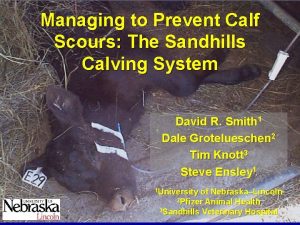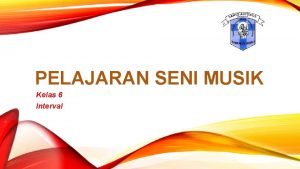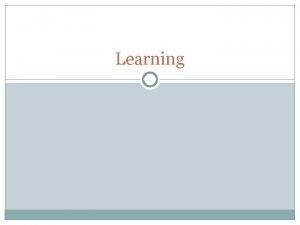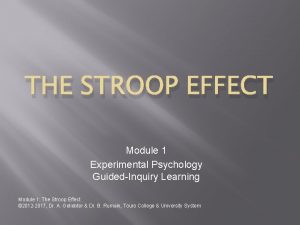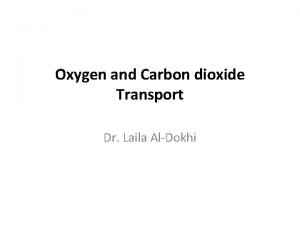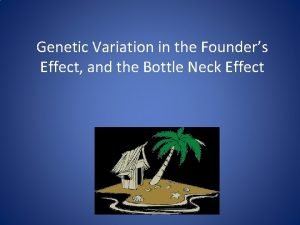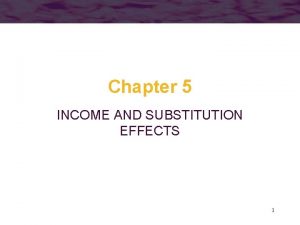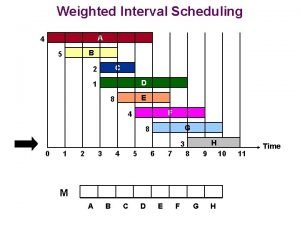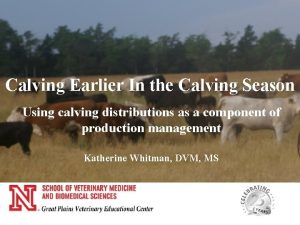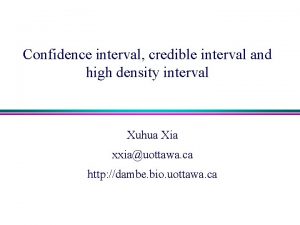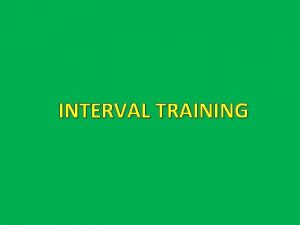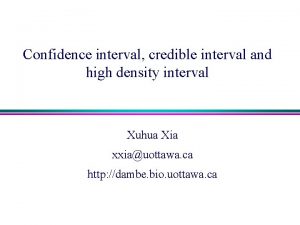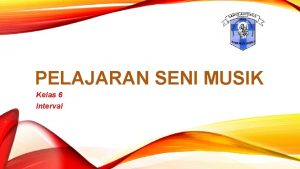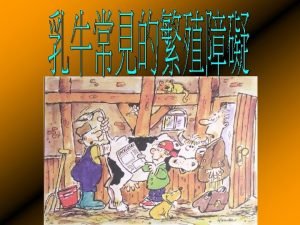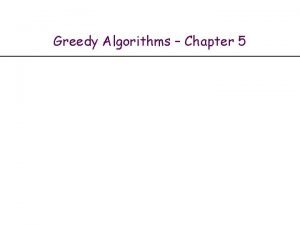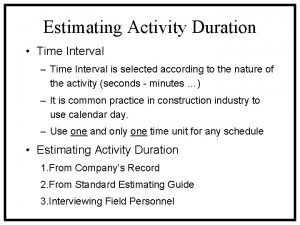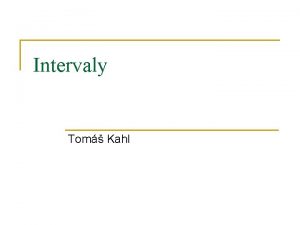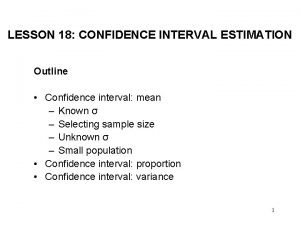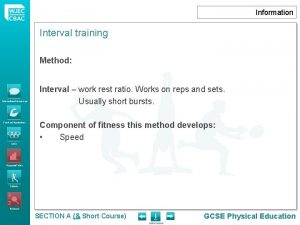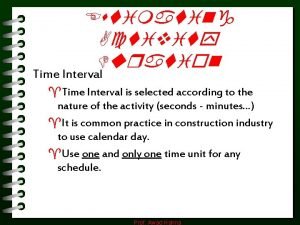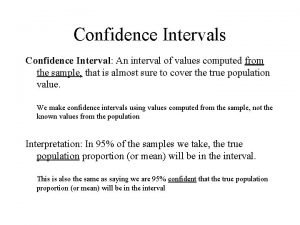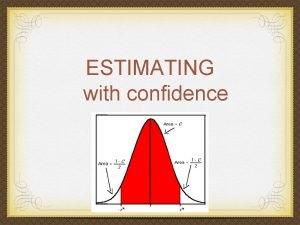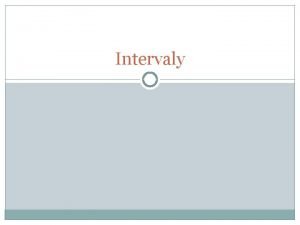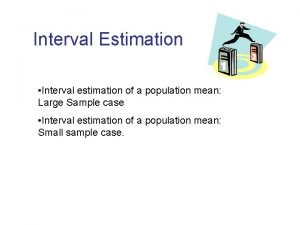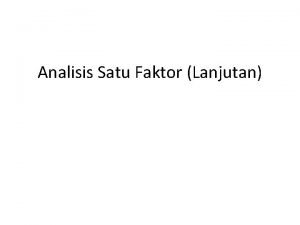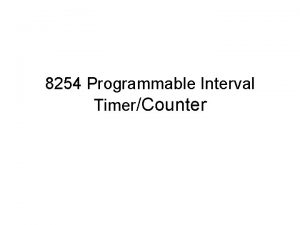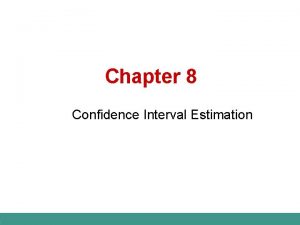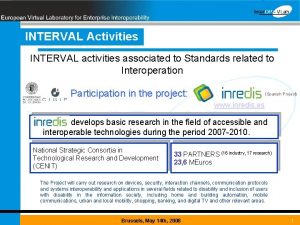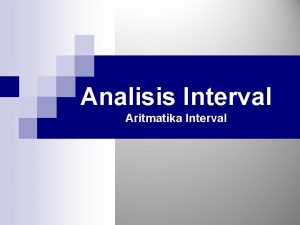Effect of calving interval on the economic results























































- Slides: 55

Effect of calving interval on the economic results of dairy farms based on their typology Anne-Catherine Dalcq*1, Yves Beckers 1, Patrick Mayeres 2, Benoit Wyzen 2, Hélène Soyeurt 1 1 Université de Liège-Gembloux Agro-Bio Tech, Gembloux, Belgium, 2 Walloon Breeding Association, Ciney, Belgium

The calving interval is extending…

The calving interval is extending… • United States of America: 392 407 days from 1991 to 2002 (USDA, 2002)

The calving interval is extending… • United States of America: 392 407 days from 1991 to 2002 (USDA, 2002) • The Netherlands: 390 417 days from 1995 to 2012 (CRV, 2012)

The calving interval is extending… • The Walloon Region (AWE, 2014) : Calving interval (days) • United States of America: 392 407 days from 1991 to 2002 (USDA, 2002) • The Netherlands: 390 417 days from 1995 to 2012 (CRV, 2012) 450 440 430 420 410 400 390 380 1980 Year

The calving interval is extending… • The Walloon Region (AWE, 2014) : Calving interval (days) • United States of America: 392 407 days from 1991 to 2002 (USDA, 2002) • The Netherlands: 390 417 days from 1995 to 2012 (CRV, 2012) 450 440 430 420 410 400 390 380 1980 Year Which impact on the economic results of the farm?

The calving interval is extending… • The Walloon Region (AWE, 2014) : Calving interval (days) • United States of America: 392 407 days from 1991 to 2002 (USDA, 2002) • The Netherlands: 390 417 days from 1995 to 2012 (CRV, 2012) 450 440 430 420 410 400 390 380 1980 Year Which impact on the economic results of the farm? Which calving interval = current economic optimum?

Available data? - 1568 balance sheets Walloon Breeding Association 2007 -2013 373 farms Geographical localisation : Région herbagère liégeoise

Available data? - 1568 balance sheets Walloon Breeding Association 2007 -2013 373 farms Geographical localisation : Région herbagère liégeoise Information per herd*year

Global approach • Relation between gross margin/ cow and CI

Global approach • Relation between gross margin/ cow and CI = total production (milk and meat) – variable costs (herd and feeding)

Global approach = total production (milk and meat) – variable costs (herd and feeding) Gross margin per cow (€/cow) • Relation between gross margin/ cow and CI 4000 3000 2000 1000 0 300 Calving interval (days)

Global approach = total production (milk and meat) – variable costs (herd and feeding) Gross margin per cow (€/cow) • Relation between gross margin/ cow and CI 4000 3000 2000 1000 0 300 Calving interval (days) Not ONE economic optimum of CI Several economic optimum of CI, depending on the farm?

Typological approach Study of the relation between the economic results and the CI in groups of farms showing the same typology

Which typology? Study of the relation between the economic results and the CI in groups of farms showing the same typology Typological variables

Which typology? Study of the relation between the economic results and the CI in groups of farms showing the same typology Typological variables Ares of corn silage (CS)/ livestock unit (LU)

Which typology? Study of the relation between the economic results and the CI in groups of farms showing the same typology Typological variables Ares of corn silage (CS)/ livestock unit (LU) Ares of grass/ LU

Which typology? Study of the relation between the economic results and the CI in groups of farms showing the same typology Typological variables Ares of corn silage (CS)/ livestock unit (LU) Ares of grass/ LU Concentrate / cow

Which typology? Study of the relation between the economic results and the CI in groups of farms showing the same typology Numerical classification Typological variables Ares of corn silage (CS)/ livestock unit (LU) Qualitative typological variables Ares of grass/ LU Concentrate / cow

Creation of groups showing the same typology Study of the relation between the economic results and the CI in groups of farms showing the same typology Multiple correspondence analysis Typological variables Qualitative typological variables 4 typological groups

Description of the groups Study of the relation between the economic results and the CI in groups of farms showing the same typology Multiple correspondence analysis Qualitative typological variables Typological variables 4 typological groups Intensive group Less intensive group Intensive group without CS Extensive group 0 1 2 3 4 Ares of CS/ LU 5 6 0 20 40 Ares of grass / LU 60 0 1000 2000 Concentrate / cow 3000

Description of the groups Study of the relation between the economic results and the CI in groups of farms showing the same typology Multiple correspondence analysis Qualitative typological variables Typological variables 4 typological groups Intensive group Less intensive group Intensive group without CS Extensive group 0 1 2 3 4 Ares of CS/ LU 5 6 0 20 40 Ares of grass / LU 60 0 1000 2000 Concentrate / cow 3000

Description of the groups Study of the relation between the economic results and the CI in groups of farms showing the same typology Multiple correspondence analysis Qualitative typological variables Typological variables 4 typological groups Intensive group Less intensive group Intensive group without CS Extensive group 0 1 2 3 4 Ares of CS/ LU 5 6 0 20 40 Ares of grass / LU 60 0 1000 2000 Concentrate / cow 3000

Description of the groups Study of the relation between the economic results and the CI in groups of farms showing the same typology Multiple correspondence analysis Qualitative typological variables Typological variables 4 typological groups Intensive group Less intensive group Intensive group without CS Extensive group 0 1 2 3 4 Ares of CS/ LU 5 6 0 20 40 Ares of grass / LU 60 0 1000 2000 Concentrate / cow 3000

Modelling in each group Study of the relation between the economic results and the CI in groups of farms showing the same typology Typological variables Qualitative typological variables 4 typological groups Modelling economic results by CI

Modelling economic results in function of … Study of the relation between the economic results and the CI in groups of farms showing the same typology CI variables: - % cows in the herd with CI > 459 days organized in 4 classes <17% 18 -26% 27 -37% >38%

Modelling economic results in function of … Study of the relation between the economic results and the CI in groups of farms showing the same typology CI variables: - CI profile organized in 5 classes determined by Numerical Classification on the variables CI profile % of cows in the herd with CI < 380 days % of cows in the herd with 380 < CI < 419 days % of cows in the herd with 420 < CI < 459 days % of cows in the herd with CI > 459 days

Modelling economic results in function of … Study of the relation between the economic results and the CI in groups of farms showing the same typology CI variables: - CI profile organized in 5 classes determined by Numerical Classification on the variables CI profile Short CI % of cows in the herd with CI < 380 days 52 % of cows in the herd with 380 < CI < 419 days 19 % of cows in the herd with 420 < CI < 459 days 9 % of cows in the herd with CI > 459 days 18

Modelling economic results in function of … Study of the relation between the economic results and the CI in groups of farms showing the same typology CI variables: - CI profile organized in 5 classes determined by Numerical Classification on the variables CI profile Short Long CI % of cows in the herd with CI < 380 days 52 28 % of cows in the herd with 380 < CI < 419 days 19 17 % of cows in the herd with 420 < CI < 459 days 9 13 % of cows in the herd with CI > 459 days 18 41

Modelling economic results in function of … Study of the relation between the economic results and the CI in groups of farms showing the same typology CI variables: - CI profile organized in 5 classes determined by Numerical Classification on the variables CI profile Short Inter. A Inter. B Inter. C Long CI % of cows in the herd with CI < 380 days 52 27 30 37 28 % of cows in the herd with 380 < CI < 419 days 19 24 20 19 17 % of cows in the herd with 420 < CI < 459 days 9 27 14 18 13 % of cows in the herd with CI > 459 days 18 22 25 25 41

Milk production & calving interval Study of the relation between the economic results and the CI in groups of farms showing the same typology - No significant relations between gross margin/ cow and CI variables

Milk production & calving interval Study of the relation between the economic results and the CI in groups of farms showing the same typology - No significant relations between gross margin/ cow and CI variables - Assumption : In a given group, economic results when milk production

Milk production & calving interval Study of the relation between the economic results and the CI in groups of farms showing the same typology - No significant relations between gross margin/ cow and CI variables - Assumption : In a given group, economic results when milk production Pearson’s r : milk production/ cow & gross margin/ cow Intensive group Less intensive group Intensive group without CS Extensive group 0. 54*** 0. 56*** 0. 53*** 0. 55***

8500 8000 a/b b a a 7500 7000 6500 6000 5500 Milk production / cow (l/cow) Milk production in function of CI in EACH group Intensive group Less intensive group 8500 8000 7500 a/b a/b b 7500 7000 6500 6000 5500 Short CI Intermediate A CI B CI CI profile Long CI a 6500 6000 5500 < 17% 18 -26% 27 -37% > 38% % cows in the herd with CI > 459 days Milk production / cow (l/cow) 8000 a 8527, 78 947 b a/b 7000 < 17% 18 -26% 27 -37% > 38% % cows in the herd with CI > 459 days 8500 a/b 8500 8000 7500 a/b a/b b a 7000 6500 6000 5500 Short CI Intermediate A CI B CI CI profile Long CI

8500 8000 a/b b a a 7500 7000 6500 6000 5500 Milk production / cow (l/cow) Milk production in function of CI in EACH group Intensive group Less intensive group 8500 8000 7500 a/b a/b b 7500 7000 6500 6000 5500 Short CI Intermediate A CI B CI CI profile Long CI a 6500 6000 5500 < 17% 18 -26% 27 -37% > 38% % cows in the herd with CI > 459 days Milk production / cow (l/cow) 8000 a 8527, 78 947 b a/b 7000 < 17% 18 -26% 27 -37% > 38% % cows in the herd with CI > 459 days 8500 a/b 8500 8000 7500 a/b a/b b a 7000 6500 6000 5500 Short CI Intermediate A CI B CI CI profile Long CI

8500 8000 a/b b a a 7500 7000 6500 6000 5500 Milk production / cow (l/cow) Milk production in function of CI in EACH group Intensive group Less intensive group 8500 8000 7500 a/b a/b b 7500 7000 6500 6000 5500 Short CI Intermediate A CI B CI CI profile Long CI a 6500 6000 5500 < 17% 18 -26% 27 -37% > 38% % cows in the herd with CI > 459 days Milk production / cow (l/cow) 8000 a 8527, 78 947 b a/b 7000 < 17% 18 -26% 27 -37% > 38% % cows in the herd with CI > 459 days 8500 a/b 8500 8000 7500 a/b a/b b a 7000 6500 6000 5500 Short CI Intermediate A CI B CI CI profile Long CI

Milk production / cow (l/cow) Milk production in function of CI in EACH group Intensive group Extensive group 8500 8000 a/b b a a 7500 7000 6500 6000 5500 Milk production / cow (l/cow) < 17% 18 -26% 27 -37% > 38% % cows in the herd with CI > 459 days 8500 8000 a/b a 8527, 78 947 a/b b 7500 7000 6500 6000 5500 Short CI Intermediate A CI B CI CI profile Long CI

8500 8000 a/b b a a 7500 7000 6500 6000 5500 Mil production / cow (l/cow) Milk production in function of CI in EACH group Intensive group Extensive group 8500 8000 7500 7000 6500 6000 5500 8000 a/b a 8527, 78 947 a/b b 7500 7000 6500 6000 5500 Short CI Intermediate A CI B CI CI profile Long CI < 17% 18 -26% 27 -37% > 38% % cows in the herd with CI > 459 days Milk production / cow (l/cow) < 17% 18 -26% 27 -37% > 38% % cows in the herd with CI > 459 days 8500 a/b a a b 8500 8000 7500 7000 6500 6000 5500 a Short CI a/b b b Intermediate A CI B CI CI profile b Long CI

Milk production / cow (l/cow) Milk production in function of CI in EACH group Intensive group without CS Intensive group 8500 8000 a/b b a a 7500 7000 6500 6000 5500 Milk production / cow (l/cow) < 17% 18 -26% 27 -37% > 38% % cows in the herd with CI > 459 days 8500 8000 a/b a 8527, 78 947 a/b b 7500 7000 6500 6000 5500 Short CI Intermediate A CI B CI CI profile Long CI

8500 8000 a/b b a a 7500 7000 6500 6000 5500 Milk production / cow (l/cow) Milk production in function of CI in EACH group Intensive group without CS Intensive group 8500 8000 7500 a/b a/b b 7500 7000 6500 6000 5500 Short CI Intermediate A CI B CI CI profile Long CI a a 6500 6000 5500 < 17% 18 -26% 27 -37% > 38% % cows in the herd with CI > 459 days Milk production / cow (l/cow) 8000 a 8527, 78 947 a 7000 < 17% 18 -26% 27 -37% > 38% % cows in the herd with CI > 459 days 8500 a 8500 8000 7500 7000 6500 a a/b b a/b 6000 5500 Short CI Intermediate A CI B CI CI profile Long CI

Why ? • Longer voluntary waiting period (10 weeks vs 6 weeks) = economically optimum under some conditions (Inchaisri et al. , 2011):

Why ? • Longer voluntary waiting period (10 weeks vs 6 weeks) = economically optimum under some conditions (Inchaisri et al. , 2011): - No Holstein-Friesian breed In the dataset used : % herds in the group with Hostein as main breed Intensive group Less intensive group Intensive Extensive group without CS 92 91 67 62

Why ? • Longer voluntary waiting period (10 weeks vs 6 weeks) = economically optimum under some conditions (Inchaisri et al. , 2011): - No Holstein-Friesian breed - Low herd milk production

8500 8000 a/b b a a 7500 7000 6500 6000 5500 Mil production / cow (l/cow) Milk production in function of CI in EACH group Intensive group Extensive group 8500 8000 7500 7000 6500 6000 5500 8000 a/b a 8527, 78 947 a/b b 7500 7000 6500 6000 5500 Short CI Intermediate A CI B CI CI profile Long CI < 17% 18 -26% 27 -37% > 38% % cows in the herd with CI > 459 days Milk production / cow (l/cow) < 17% 18 -26% 27 -37% > 38% % cows in the herd with CI > 459 days 8500 a/b a a b 8500 8000 7500 7000 6500 6000 5500 a Short CI a/b b b Intermediate A CI B CI CI profile b Long CI

Why ? • Longer voluntary waiting period (10 weeks vs 6 weeks) = economically optimum under some conditions (Inchaisri et al. , 2011): - No Holstein-Friesian breed - Low herd milk production - High milk persistency

Why ? • Longer voluntary waiting period (10 weeks vs 6 weeks) = economically optimum under some conditions (Inchaisri et al. , 2011): - No Holstein-Friesian breed - Low herd milk production - High milk persistency • Better persistency (670 days in milk (DIM)) for cows pasture fed (daily dietary intake 160 MJ of ME/cow) >< total mixed ration (TMR) fed (Grainger et al. , 2009)

Limits on the current research and further analyses - Information per herd

Limits on the current research and further analyses - Information per herd averaged information

Limits on the current research and further analyses - Information per herd averaged information low tendencies observed

Limits on the current research and further analyses - Information per herd averaged information low tendencies observed - Future research information per cow

Limits on the current research and further analyses - Information per herd averaged information low tendencies observed - Future research information per cow - explain the present results (persistency)

Limits on the current research and further analyses - Information per herd averaged information low tendencies observed - Future research information per cow - explain the present results (persistency) - confirm the low tendencies observed

Limits on the current research and further analyses - Information per herd averaged information low tendencies observed - Future research information per cow - explain the present results (persistency) - confirm the low tendencies observed identify CI objectives for dairy farmers

Acknowledgments - Unit of Modelling and Development, Gx-ABT, Ulg - University of Liège - Walloon Breeding Association

Take home message Different technicoeconomic optimum of calving interval, depending on the typology Optimum of CI = Intensive: Short CI E-mail : anne-catherine. dalcq@ulg. ac. be Extensive: Long CI
 Sandhills calving system
Sandhills calving system Interval diperlukan dalam penciptaan musik interval adalah
Interval diperlukan dalam penciptaan musik interval adalah Fixed ratio schedule
Fixed ratio schedule Fixed interval vs fixed ratio
Fixed interval vs fixed ratio The basic economic problem results from scarcity
The basic economic problem results from scarcity Stroop effect results table
Stroop effect results table Economic growth vs economic development
Economic growth vs economic development What is economic growth and development
What is economic growth and development Lesson 2 our economic choices
Lesson 2 our economic choices Chloride shift
Chloride shift Bottleneck effect
Bottleneck effect Income effect graph
Income effect graph Hát kết hợp bộ gõ cơ thể
Hát kết hợp bộ gõ cơ thể Lp html
Lp html Bổ thể
Bổ thể Tỉ lệ cơ thể trẻ em
Tỉ lệ cơ thể trẻ em Voi kéo gỗ như thế nào
Voi kéo gỗ như thế nào Thang điểm glasgow
Thang điểm glasgow Hát lên người ơi alleluia
Hát lên người ơi alleluia Môn thể thao bắt đầu bằng từ đua
Môn thể thao bắt đầu bằng từ đua Thế nào là hệ số cao nhất
Thế nào là hệ số cao nhất Các châu lục và đại dương trên thế giới
Các châu lục và đại dương trên thế giới Công thức tính độ biến thiên đông lượng
Công thức tính độ biến thiên đông lượng Trời xanh đây là của chúng ta thể thơ
Trời xanh đây là của chúng ta thể thơ Mật thư anh em như thể tay chân
Mật thư anh em như thể tay chân Phép trừ bù
Phép trừ bù Phản ứng thế ankan
Phản ứng thế ankan Các châu lục và đại dương trên thế giới
Các châu lục và đại dương trên thế giới Thơ thất ngôn tứ tuyệt đường luật
Thơ thất ngôn tứ tuyệt đường luật Quá trình desamine hóa có thể tạo ra
Quá trình desamine hóa có thể tạo ra Một số thể thơ truyền thống
Một số thể thơ truyền thống Cái miệng nó xinh thế chỉ nói điều hay thôi
Cái miệng nó xinh thế chỉ nói điều hay thôi Vẽ hình chiếu vuông góc của vật thể sau
Vẽ hình chiếu vuông góc của vật thể sau Nguyên nhân của sự mỏi cơ sinh 8
Nguyên nhân của sự mỏi cơ sinh 8 đặc điểm cơ thể của người tối cổ
đặc điểm cơ thể của người tối cổ V. c c
V. c c Vẽ hình chiếu đứng bằng cạnh của vật thể
Vẽ hình chiếu đứng bằng cạnh của vật thể Phối cảnh
Phối cảnh Thẻ vin
Thẻ vin đại từ thay thế
đại từ thay thế điện thế nghỉ
điện thế nghỉ Tư thế ngồi viết
Tư thế ngồi viết Diễn thế sinh thái là
Diễn thế sinh thái là Dạng đột biến một nhiễm là
Dạng đột biến một nhiễm là Các số nguyên tố
Các số nguyên tố Tư thế ngồi viết
Tư thế ngồi viết Lời thề hippocrates
Lời thề hippocrates Thiếu nhi thế giới liên hoan
Thiếu nhi thế giới liên hoan ưu thế lai là gì
ưu thế lai là gì Hổ sinh sản vào mùa nào
Hổ sinh sản vào mùa nào Khi nào hổ con có thể sống độc lập
Khi nào hổ con có thể sống độc lập Hệ hô hấp
Hệ hô hấp Từ ngữ thể hiện lòng nhân hậu
Từ ngữ thể hiện lòng nhân hậu Thế nào là mạng điện lắp đặt kiểu nổi
Thế nào là mạng điện lắp đặt kiểu nổi Defensive interval ratio
Defensive interval ratio Weighted interval scheduling
Weighted interval scheduling
